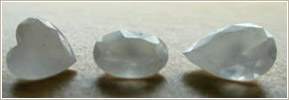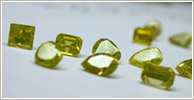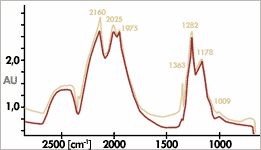|
 To generate colour changes – colouring, colour change, removal of colour – means for diamond to influence its crystal structure, to generate or to heal up defects in them, namely such defects that are colour centres. It is known for long time, that high – energy irradiation can cause colour centres in diamond. If at first had been used types of radiation at radioactive decay, so later have been used other kinds of radiation sources with neutral particles (neutrons) or charged particles (e.g. electrons). To generate colour changes – colouring, colour change, removal of colour – means for diamond to influence its crystal structure, to generate or to heal up defects in them, namely such defects that are colour centres. It is known for long time, that high – energy irradiation can cause colour centres in diamond. If at first had been used types of radiation at radioactive decay, so later have been used other kinds of radiation sources with neutral particles (neutrons) or charged particles (e.g. electrons).
 For a long time these techniques of ray treatment with neutrons and high-energy electrons were the only methods for generation of different colours in diamonds. From these experiments results a lot of knowledge about colour centres. High energy radiation generates first of all so called Frenkel – defects, where atoms are shifted from their lattice position to interstitial sites. Generated this way vacancies (vacant lattice sites ), so called GR1-centres, cause an absorption at a wave length of 741 nm, what can result in a more or less intense blue colour depending on the concentration of the centres. Such configurations of vacancies on interstitial sites are not stable. They can heal out already at room temperature and the colour disappears. Moreover the diamonds treated this way always show the low repute of radiation, so they meet with low approval and are clearly undervaluated. For a long time these techniques of ray treatment with neutrons and high-energy electrons were the only methods for generation of different colours in diamonds. From these experiments results a lot of knowledge about colour centres. High energy radiation generates first of all so called Frenkel – defects, where atoms are shifted from their lattice position to interstitial sites. Generated this way vacancies (vacant lattice sites ), so called GR1-centres, cause an absorption at a wave length of 741 nm, what can result in a more or less intense blue colour depending on the concentration of the centres. Such configurations of vacancies on interstitial sites are not stable. They can heal out already at room temperature and the colour disappears. Moreover the diamonds treated this way always show the low repute of radiation, so they meet with low approval and are clearly undervaluated.
 For some years an other, radiation free method of treatment for colour changes of diamonds has been used. This is the high pressure – high temperature – treatment (HP – HT – Treatment), always above the stability line between graphite and diamond, i.e. at pressure about or above 5 GPa (50 kbar) and temperatures between 1800 K and 2300 K. This treatment is made in the presses that are used for the production of synthetic diamonds too. The pressure- and temperature conditions are comparable among each other and are roughly comparable with the geodynamic conditions of the natural diamond generation. The conditions are therefore very close to the nature, but if by far not about the time. For some years an other, radiation free method of treatment for colour changes of diamonds has been used. This is the high pressure – high temperature – treatment (HP – HT – Treatment), always above the stability line between graphite and diamond, i.e. at pressure about or above 5 GPa (50 kbar) and temperatures between 1800 K and 2300 K. This treatment is made in the presses that are used for the production of synthetic diamonds too. The pressure- and temperature conditions are comparable among each other and are roughly comparable with the geodynamic conditions of the natural diamond generation. The conditions are therefore very close to the nature, but if by far not about the time.
The result of such a HP – HT - treatment depends not only on the pressure – temperature – conditions and the duration of an experiment, but from the conditions that the diamond brings itself along and the chemical and the structural defects it has inside. At first this is an statistical problem. Diamonds of type IIa contain very low or at least low nitrogen and are therefore hardly able to contain enough colour centres fixed to nitrogen. Diamonds of type Ia can contain more or less nitrogen (mostly between 100 and 1000 ppm) and give the best conditions for colour centres fixed to nitrogen. This way is given at least the tendency for specific statements concerning the colour effects to be expected. But then has to be considered, that each diamond has its individual properties, which make impossible to give precise predictions for each single diamond, so for example concerning removal of colour, discrete colour, colouring or colour saturation.
 The HP – HT – treatment in general is used to enhance brown natural diamonds, which are valued too low or not usable as jewellery. Here can occur a drastic colour change. At type IIa diamonds the brown colour results from intense plastic deformations. The generated with it high dislocation densities of about 1015 mm-3 cause high concentrations of interrupted bonds, where the carbon atoms are submonoatomic at the dislocation lines or planes in the graphite - like sp2 – hybridizated state and result in a nontypical background absorption in the visible. The HP – HT – treatment causes an healing up of structural defects. The dislocation density is decreased, interrupted bonds recombine and the brown colouring is reduced nearly up to colourless. The HP – HT – treatment in general is used to enhance brown natural diamonds, which are valued too low or not usable as jewellery. Here can occur a drastic colour change. At type IIa diamonds the brown colour results from intense plastic deformations. The generated with it high dislocation densities of about 1015 mm-3 cause high concentrations of interrupted bonds, where the carbon atoms are submonoatomic at the dislocation lines or planes in the graphite - like sp2 – hybridizated state and result in a nontypical background absorption in the visible. The HP – HT – treatment causes an healing up of structural defects. The dislocation density is decreased, interrupted bonds recombine and the brown colouring is reduced nearly up to colourless.
 Type Ia diamonds change their brown colours at HP – HT – treatment to bright yellow – green colours of different tones and saturations. Cause of this is the generation of different colour centres fixed to nitrogen, so called VN complexes, vacancies (V = vacancy) and nitrogen atoms in certain arrangements. They generate partly by catching of vacancies by a nitrogen pair (A - centre with absorption maximum in IR at a wave number of 1282 cm-1) to a H3 – centre (one aggregate and one (or two) neutral vacancies) with an absorption at 503 nm, or by an B – aggregate (B = 4 N – atoms at the edges of an tetrahedron with central vacancy, IR – absorption maximum at 1175 cm-1) to a H4-centre with an absorption at 496 nm. Further VN - complexes are the N3 and N2 named colour centres, triangular arrangements of three nitrogen atoms with neutral or negative charged vacancy, with absorption at 415 nm resp. 478 nm, NVo- resp. NV--centres (always one N-atom with one neutral resp. negative vacancy), with absorption at 575 nm resp. 637 nm, as well as the H2-centres, though with analogous configurations as the H3-centre, but in negative charged state, with absorption in the near infrared at 986 nm and resonances up to the visible region. The last mentioned centres can be generated from the dissociation of the A- or B-aggregates as the disintegration of platelets. The colours generate then from the different proportions of the colour centres and their corresponding absorption bonds and possibly further optical effects, often the cause of it is not yet clear. Type Ia diamonds change their brown colours at HP – HT – treatment to bright yellow – green colours of different tones and saturations. Cause of this is the generation of different colour centres fixed to nitrogen, so called VN complexes, vacancies (V = vacancy) and nitrogen atoms in certain arrangements. They generate partly by catching of vacancies by a nitrogen pair (A - centre with absorption maximum in IR at a wave number of 1282 cm-1) to a H3 – centre (one aggregate and one (or two) neutral vacancies) with an absorption at 503 nm, or by an B – aggregate (B = 4 N – atoms at the edges of an tetrahedron with central vacancy, IR – absorption maximum at 1175 cm-1) to a H4-centre with an absorption at 496 nm. Further VN - complexes are the N3 and N2 named colour centres, triangular arrangements of three nitrogen atoms with neutral or negative charged vacancy, with absorption at 415 nm resp. 478 nm, NVo- resp. NV--centres (always one N-atom with one neutral resp. negative vacancy), with absorption at 575 nm resp. 637 nm, as well as the H2-centres, though with analogous configurations as the H3-centre, but in negative charged state, with absorption in the near infrared at 986 nm and resonances up to the visible region. The last mentioned centres can be generated from the dissociation of the A- or B-aggregates as the disintegration of platelets. The colours generate then from the different proportions of the colour centres and their corresponding absorption bonds and possibly further optical effects, often the cause of it is not yet clear.
The colour intensity in general does not depend on the nitrogen content of a diamond, but more of the number of vacancies that are catched by nitrogen atoms or -aggregates.
At further development of a HP - HT -treatment for colour change resp. removal of colour of diamonds it is important to understand the complicated connections and the manifold reactions inside the crystal in dependence of the parameters of state - pressure and above all temperature - as well as their individual intern conditions concerning substitutional built-in chemical tramp elements and the real structure.
It is for certain that the colour effects generated by HP - HT - treatment are stable and will not fade, neither at higher temperatures nor over a longer period.
|


